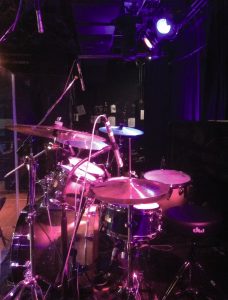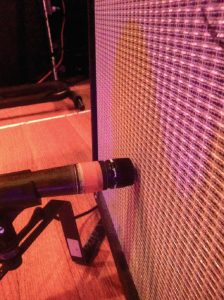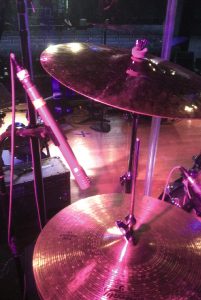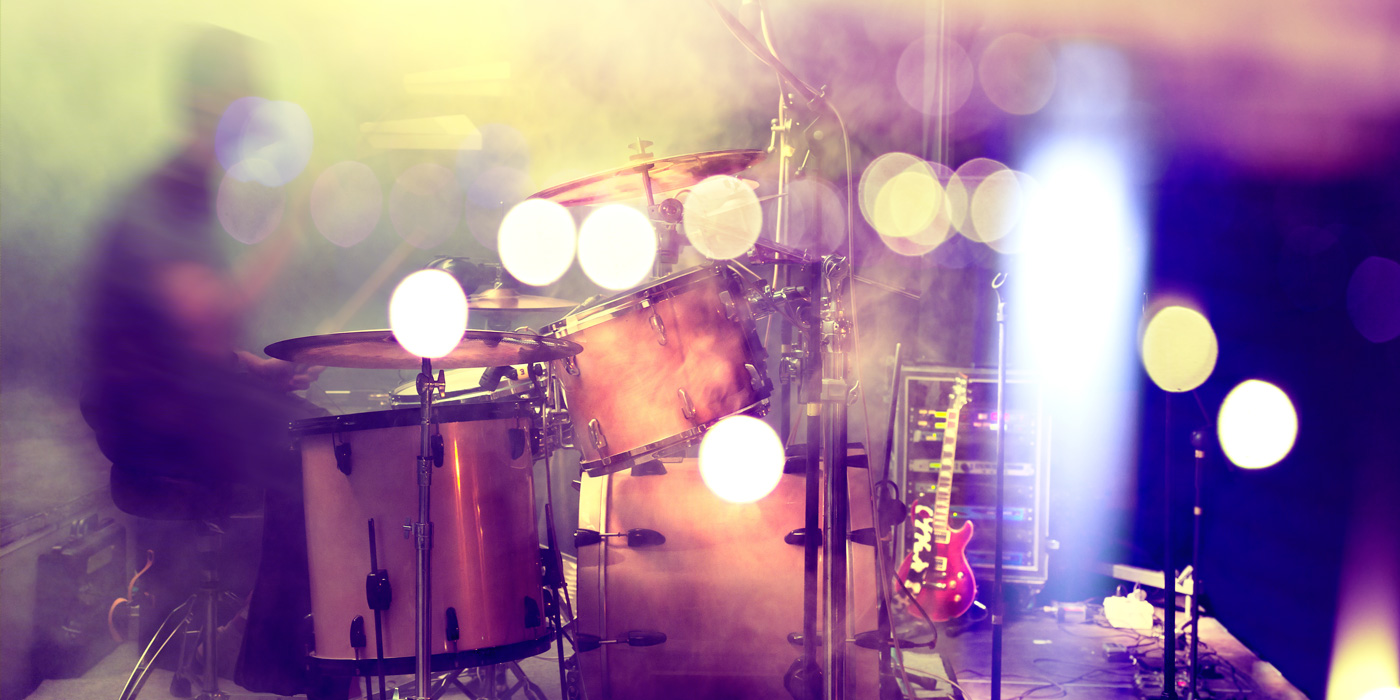How to capture a live performance—on stage and in the studio
By Eleanor Goldfield
As engineers, musicians and even fans, we’ve all seen it: a band has a live show that just absolutely crushes their studio album. Rock historians (yep, that’s a thing) like to highlight Cheap Trick as a classic example of this. Live at the Budokan sold better and was far better received than any of their previous studio albums.
Live shows are amped up by the sound of the crowd, the raw energy, the improv solos and extended bridges. Close your eyes and you can almost see the lights piercing through stage smoke, feel the pulse of the crowd as it moves. Yep, there is something undoubtedly awesome about a live recording. However, as with most things that are truly amazing, the ultimate live performance recording only comes into being after a lot of work behind the scenes.
Just as with studio recording, there are many ways you can set up a live recording. I haven’t tried them all, but I have tried several ways that worked well for me… and several ways that didn’t. I’m going to delve into what has and hasn’t worked (and why!) when I’ve tried to capture the mind-blowing awesomeness of a great stage performance.
I’m going to start on the stage with mics, their isolation and placement. From there, I’ll work my way back through beer-soaked cabling to Front Of House (FOH) and talk about different ways to capture the performance inside a DAW. Finally, for all you die-hard studio cats, I will also include some brief notes at the end on capturing a live band in the studio. Now, without further ado, let’s hit the stage!
 Setting the Stage
Setting the Stage
In live sound, unlike in the studio, you have a lot less time to figure things out (“How long do I have to set up mics?” “You should’ve been done five minutes ago.”), and certainly less-than-ideal isolation for your instruments. Preplanning becomes key to your success.
Try to check everything before show time. Even if the band doesn’t have a sound check, you can at the very least get some mic testing done to make sure signal is passing as it should. I don’t know of any venue that doesn’t do a line check, so that would then be your time to set final levels. It’s not ideal but it may be all you have.
In either case, do some pre-emptive crisis management by setting the stage up to your advantage. If it’s a big stage, move drums and amps further apart—even angle amps away from each other to allow for greater isolation. If there’s a curtain, that will help you. It will suck up some of the inevitable bleed on stage. If there isn’t, you may con-sider investing in some packing blankets to strategically place along the stage plot.
For example, your bass player is stage right next to the guitarist, who is next to the drummer. Place the bass amp between the drums and guitar; it will have a DI to fall back on, and that means you can avoid drum and guitar bleed in the bass signal. If it’s a small stage and the amps have to be practically on top of one another, throw a blanket in between them to at least suck up some of the vibrations. Gig bags, extra merch or sweaters work here too.
Speaking of DIs, they are your friends. Use them. Live sound engineers adore DIs because there’s no bleed associated with them. Obvious choices for DI are bass, acoustic guitar (if it’s an acoustic/electric) and keyboards. In the first two cases, I typically use a mic as well, to add some jagged and raw characteristics, but the DI is a crucial piece of the setup because it’s there and clean when the amp signal gets too out of hand.
Place mics as close to the sound source as possible. If the mics have multiple polar pattern options, go for the patterns that have the most rear rejection. Most dynamic mics that you’ll use for live sound—the Shure SM58 on vocals, Sennheiser MD421 on guitar amps, or Audix D6 on kick drum—will be cardioid, which is fine.
As for condensers, avoid using too many. You’ll probably end up using them for overheads and possibly for crowd mics as well. Due to the clear characteristics of these mics, they do a good job of picking up an unmuddled audience. The thing to keep in mind, however, is that condensers are generally more prone to feeding back than dynamics. The same goes for effect mics, even certain dynamic mics like the Placid Audio Copperphone. With time for testing, you can wrangle their eccentricities, but a line check may not be enough time to avoid ear-splitting feedback, so be wary.
Ringing out
And speaking of feedback and extra time, if you’re in a venue that isn’t usually used for live sound, or the artist has a mic you aren’t familiar with, ring out the wedges. If you’re unfamiliar with this practice, it’s basically an education in pain. Grab an assistant, your earplugs, and follow along with me.
Take the mic that you’ll be using for vocals and point it straight at the stage monitors. Crank up the master volume. It will feed back. Use the graphic EQ on the FOH mixer to find and pull down the frequency at which the feedback occurs until the feedback stops. Do this to each vocal mic; when you can point the mic at any wedge and not get feedback, you’ve rung out the system.
Most venues are set up to have their wedges rung out with a Shure SM58, the most common vocal mic. If an artist comes in with a special mic, you’ll want to try and ring out the PA to avoid feedback when they start moving around.
Once you’re done, bring the master volume back down to normal and test the mic to make sure that it still sounds good. If not, make some subtle adjustments to the EQ to bring things to a natural sound. Important to note: in-ear monitors make this problem beautifully disappear. More and more bands have them, but a lot still don’t. Never take it for granted that a band will have them.
Another thing to never take for granted: how the band moves on stage. I, for example, am incredibly calm and mild-mannered offstage. On stage, however, I flail, head bang, jump, twirl, stomp and scream. If there is a delicately placed mic stand anywhere near me, it will fall. Oh, and there are four other people up on stage with me.
If you’re miking up two people on stools, you may not need to consider this, but any “mobile” band, so to speak, should have hardy mic stands that are heavily weighted. If the venue has sandbags, use them. If not, find something else that can act as a weight to keep the mic in place.
As any live sound engineer knows, always bring gaffer’s tape, a knife, and a Sharpie to every gig. In addition to a stand weight, take some gaff tape and literally tape the mic stand to the stage. It doesn’t have to look pretty for your recording.
In rock music it’s common to deaden the drums a bit with gaff tape so they don’t ring too much. You can add some paper towels to the tape as well, but I typically feel that a couple of gaff tape squares on each drum will do the trick. You don’t want muffled drums, but you also don’t want them echoing into the PA looking for feedback.
 Mic placement tips
Mic placement tips
There are several companies that offer drum mic kits; Shure and Audix are two of the brands that I’ve personally used. There are varying kit sizes and styles; most come with drum rim mounts so that you can place the mics directly on the drums, without having to jury-rig a mic stand between two toms.
Regardless of whether or not you get a mic kit, I suggest miking the kick with two mics if you can spare them; one on the inside, one on the outside. You can choose to mic the snare on both top and bottom, depending on the sound of the snare. Mic each tom—high, middle, floor—and if there are any extra pieces like a cowbell or chimes, those should get their own mic too.
For a live recording, you’ll more than likely want to have overhead mics as well. Ones that I’ve had a lot of positive experience with are the Shure KSM32, Shure SM81, Audix ADX51, AKG C451, and even the Audix D2 and D4.
What about other cymbals? I hear people say there’s no need to mic the hi-hat in a live situation because the overheads will pick it up. While I see this point, I like to give myself more than I need going in, so that I’m not left searching for something on the back end.
A friend of mine, Matthew Andrade, who tours and also runs sound at the Viper Room in Hollywood, likes to put a mic under the ride cymbal as well. And if he’s “feeling frisky,” as he puts it, he’ll also throw a mic on the side of the snare to capture rimshots!
At the end of the day, consider what you think you’ll need and add a bit extra if you can. I can say that there have been more than a few times where I’ve thanked myself for adding that extra mic… and where I’ve kicked myself for leaving it out.
This goes for the other instruments as well. Set up a couple of mics on the guitar cab(s) if you can. I typically put a mic up in front of the bass cab as well, just to have it in the mix for added growl. A lone DI on bass can be very clean and plucky-sounding. If there’s an acoustic guitar, a keyboard with an amp, an actual piano, etc., use the same concept of close miking.
One final issue to deal with is stage volume. My band’s guitarist has a vintage Marshall amp that he just loves to crank. Unfortunately, doing so in small clubs means there’s pretty much nowhere to put him in the PA, let alone hear my vocals over the crushing midrange volume of his amp.
If you happen upon this situation, try to get everyone to turn their instruments to the appropriate volume, creating an onstage level that allows the band to hear themselves and also gives you, the engineer, more control over what goes through the PA and record rig. However, if the guitarist’s sound is inextricably tied to high volume, well, you can’t argue with that. Try facing the cab to the back of the stage (again, it doesn’t always have to look pretty) or to the side, giving you more wiggle room on how much sound is put through wedges and the PA.
Front Of House
Now that you have your mics all lined up and ready to go, it’s time to get them to FOH. Whether you’re at a live venue or making one out of a new space, you’ll need a snake of some kind with a stage box at one end. For live recording, you’ll ideally want to split the signal so that the one mic signal goes to either two or three places. If you have a two-way split, you’ll send it to a recording rig and the FOH console. If you have a three-way split, you can also send it to monitors so that those are separately controlled off their own board.
This is the ideal way of running things, even more so if the splitters are transformer-isolated so as to block out electrical hum. This way, you can have an entirely separate recording rig with as many inputs as your FOH console, recording the show at appropriate levels, through whatever processors you like, without being dependent on the levels set on the FOH console.
However, there will be times when even a two-way split seems a luxury. In this case, you’ll need to make do with a stereo output recording. In other words, you’ll take a left/right signal from the FOH board and input it into an external recording device.
The main hurdle here, of course, is getting a balanced mix. For example, you might hear a lot of bass in the venue and think that there’s enough bass in the stereo output, when in reality it’s just a bass-heavy venue and you actually have little to no bass in your recording. Bummer.
Unlike the case with split signals, where you can set the levels on your recording rig independent of FOH, here you’ll need to rely on the FOH mixer to set your levels and send a stereo feed your way.
Most live sound boards will have a matrix section. The matrix (take the red pill) is essentially a mixer within a mixer; it allows you to use onboard buses to send a Left/Right feed through a different output than the main L/R.
Now, follow along with me here. In the matrix, there are Aux Send knobs that correspond to the board’s Aux outputs. What you want are two Aux buses that are prefader (so their levels are unaffected by the levels the FOH engineer sets on the board). These are usually used to set levels for a monitor mix (and you have to talk to the FOH engineer about which buses he can spare from this task for you to use), but you’re going to borrow two of them (or just one if it’s stereo) for your recording rig.
For simplicity’s sake, let’s say we’re using Aux 1 and 2. Each input channel will have sends to the matrix for these Auxes. You’ll set your Aux 1/2 Send levels on each channel to provide the appropriate level for your recording. You can then go out of the matrix outputs and into a recording device—Aux Sends 1 and 2 are providing all the inputs, mixed and balanced to your desired levels. You can also mix in the master bus on this as well, to create a blend, but that’s up to you.
If you have the ability to monitor what you’re recording and make small adjustments before the show starts, absolutely do so. During the show, you can only adjust individual mics’ levels if the FOH engineer is willing to let you reach past him and mess with the Aux sends while he’s trying to mix the show.
 Sshhhh – recording in progress
Sshhhh – recording in progress
Now, if you want to take these live sound ideas to the cozy confines of a recording studio, many of the same approaches apply from the stage side. You want to plan on straddling the line between live energy and a clean recording.
Every studio engineer I know stresses the fact that above all, the band must be well rehearsed. They should have experience playing each song live, so that they can transfer that energy and that live muscle memory into a studio space. You want the transition from stage to studio to be as seamless as possible; any snags or hesitations in the performance will be amplified by the studio setting. To assist with this, make sure that everyone can see and hear each other.
You may or may not need or want headphones. It depends on the levels of the instruments in the room. Of course, if you’re recording vocals in the same room as opposed to, say, the control room, you’ll need to have headphones so the singer and the band can hear vocals.
You don’t want to overdo isolation to the point where the band can’t see each other. In that case, why bother trying to record “live”? Instead, set people up so that they feel comfortable and then build isolation around them. For example, if you have a three-piece where the guitar and bass players are facing the drummer, you may set up short gobos that allow the drummer to see over the top of them. You may put isolation between the bass and guitar cabinets, and then make use of cardioid mics that provide a lot of rear rejection, cutting down on bleed. If you have the band all set up facing one direction, closely side by side, throw up some figure-8 mics to allow for side rejection.
Make sure you maintain the close miking techniques. You can throw up some room mics to get ambience and raw feel, but your instrument mics should all be close. Here, of course, you don’t have to worry so much about condensers feeding back, but do keep in mind that condensers are more sensitive to SPL than dynamics.
When it comes to “stage” volume, you’ll run into the same issues here as with a live show. If the player needs volume for tone and there’s no cabinet load box handy, try facing the cab away from the action, or setting up a gobo directly in front. If you can control his level without sacrificing tone, you’ll get you more flexibility to create a good blend in the room for everyone to hear each other.
The bottom line
First and foremost, be invisible. You want to be like the National Geographic photographer who gets that amazing shot of the jaguar because the jaguar didn’t react to his presence; it just kept doing its thing as if the photographer wasn’t even there.
That’s how your setup needs to be. Allow the musicians to be the unknowing jaguar, just doing what they do while you get something worthy of a cover story.


